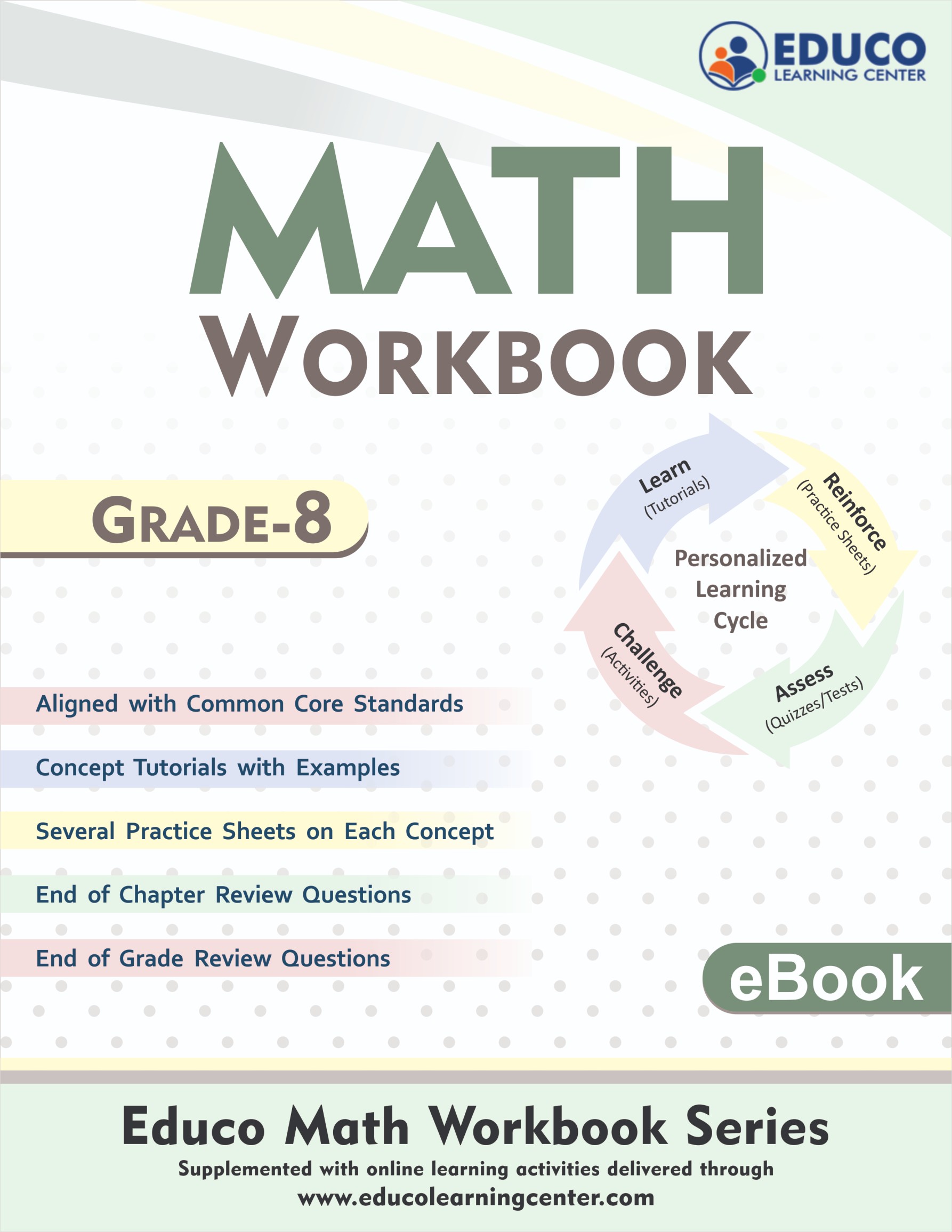Grade 8 Mathematics Course Details
Building unique learning experiences with the courses mapped to the national standards.
Course Metrics
-
 Skills
161
Skills
161 -
 Tutorials
101
Tutorials
101 -
 Video Lessons
52
Video Lessons
52 -
 Examples
285
Examples
285 -
 Free Response Questions
4000
Free Response Questions
4000 -
 Multiple Choice Questions
870
Multiple Choice Questions
870 -
 Online Practice Assessments
36
Online Practice Assessments
36 -
 Offline Practice Sheets (print)
82
Offline Practice Sheets (print)
82 -
 Graded Assessments
38
Graded Assessments
38
Overview
In the Grade 8 Math curriculum at Educo Learning Center (ELC), the focus is on essential topics aligned with the Common Core standards. Students will learn how to formulate and reason about expressions and equations in Grade 8 Math, including modeling an association in bivariate data with a linear equation and solving linear equations and systems of linear equations. In addition, they will learn to use functions to describe quantitative relationships, analyze two- and three-dimensional space and figures using distance, angle, similarity, and congruence, and apply the Pythagorean Theorem.
The grade 8 Math curriculum at Educo Learning Center includes interactive tutorials, unlimited online practice, printable practice sheets or e-workbooks, online assignments and tests, instant feedback with solutions, and detailed progress reports. The curriculum focuses on real-world problem-solving and visual representations to achieve grade-level outcomes.
"I Can" Statements For Math Grade 8
| Standard | 8.NS.A.1 |
|---|---|
| Standard Description | 1. Know that numbers that are not rational are called irrational. Understand informally that every number has a decimal expansion; for rational numbers, show that the decimal expansion repeats eventually and converts a decimal expansion which repeats eventually into a rational number. |
| Online Corse Hierarchy | 1.1 |
| I Can Statements | I can show that every number has a decimal. I can change every repeating decimal into a rational number. I can show that the decimal expansion eventually repeats for rational numbers. I can change a repeating decimal expansion into a rational number. |
| Standard | 8.NS.A.2 |
|---|---|
| Standard Description | 2. Use rational approximations of irrational numbers to compare the size of irrational numbers, locate them approximately on a number line diagram, and estimate the value of expressions (e.g., π^2). For example, by truncating the decimal expansion of √2, show that √2 is between 1 and 2, then between 1.4 and 1.5, and explain how to continue on to get better approximations. |
| Online Corse Hierarchy | 1.1 |
| I Can Statements | I can use rational approximations of irrational numbers to compare the size of irrational numbers, locate and plot them approximately on a number line diagram, and then estimate the value of the expressions. |
| Standard | 8.EE.A.1 |
|---|---|
| Standard Description | 1. Know and apply the properties of integer exponents to generate equivalent numerical expressions. For example, 32 × 3 -5 = 3-3 = 1/33 = 1/27. |
| Online Corse Hierarchy | 2.1 |
| I Can Statements | I can use the properties of integer exponents to simplify expressions. |
| Standard | 8.EE.A.2 |
|---|---|
| Standard Description | 2. Use square root and cube root symbols to represent solutions to equations of form x 2 = p and x3 = p, where p is a positive rational number. Evaluate square roots of small perfect squares and cube roots of small perfect cubes. Know that √2 is irrational. |
| Online Corse Hierarchy | 2.2 |
| I Can Statements |
I can use square and cube root symbols to represent solutions to equations of form x 2 = p and x 3 = p, where p is a positive rational number. I can evaluate the square root of a perfect square and the cube root of a perfect cube. |
| Standard | 8.EE.A.3 |
|---|---|
| Standard Description | 3. Use numbers expressed in the form of a single digit times an integer power of 10 to estimate very large or very small quantities and to express how many times as much one is than the other. For example, estimate the population of the United States as 3 × 108 and the population of the world as 7 × 109 , and determine that the world population is more than 20 times larger. |
| Online Corse Hierarchy | 2.3 |
| I Can Statements |
I can express numbers in scientific notation. I can convert scientific notation to standard form. |
| Standard | 8.EE.A.4 |
|---|---|
| Standard Description | 4. Perform operations with numbers expressed in scientific notation, including problems where both decimal and scientific notations are used. Use scientific notation and choose units of appropriate size for measurements of very large or very small quantities (e.g., use millimeters per year for seafloor spreading). Interpret scientific notation that has been generated by technology. |
| Online Corse Hierarchy | 2.3 |
| I Can Statements |
I can solve operations (+, -, x, ÷) with two numbers expressed in scientific notation, including problems that include both decimals and scientific notation. I can solve applications based on scientific notation. |
| Standard | 8.EE.B.5 |
|---|---|
| Standard Description | 5. Graph proportional relationships, interpreting the unit rate as the slope of the graph. Compare two different proportional relationships represented in different ways. For example, compare a distance-time graph to a distance-time equation to determine which of two moving objects has greater speed. |
| Online Corse Hierarchy | 3.2 |
| I Can Statements | I can graph linear equations in 2 variables using points and intercepts. |
| Standard | 8.EE.B.6 |
|---|---|
| Standard Description | 6. Use similar triangles to explain why the slope m is the same between any two distinct points on a non-vertical line in the coordinate plane; derive the equation y = mx for a line through the origin and the equation y = mx + b for a line intercepting the vertical axis at b. |
| Online Corse Hierarchy | 3.3 |
| I Can Statements | I can find the slope of a line passing through two points. I can find the slope of a line of the forms y = mx and y = mx + b. |
| Standard | 8.EE.C.7 |
|---|---|
| Standard Description | 7. Solve linear equations in one variable. a. Give examples of linear equations in one variable with one solution, infinitely many solutions, or no solutions. Show which of these possibilities is the case by successively transforming the given equation into simpler forms until an equivalent equation of the form x = a, a = a, or b. a = b results (where a and b are different numbers). c. Solve linear equations with rational number coefficients, including equations whose solutions require expanding expressions using the distributive property and collecting like terms. |
| Online Corse Hierarchy | 3.1 |
| I Can Statements | I can solve linear equations in one variable. I can simplify a linear equation by using the distributive property and combining like terms. I can give examples of linear equations with one solution, infinitely many solutions, or no solutions. I can solve linear equations with rational number coefficients, including equations when solutions require expanding expressions using the distributive property and combining like terms. |
| Standard | 8.EE.C.8 |
|---|---|
| Standard Description | 8. Analyse and solve pairs of simultaneous linear equations. |
| Standard | 8.EE.C.8a |
|---|---|
| Standard Description | a. Understand that solutions to a system of two linear equations in two variables correspond to points of intersection of their graphs because points of intersection satisfy both equations simultaneously. |
| Online Corse Hierarchy | 3.5 |
| I Can Statements | I can explain solutions to a system of two linear equations in two variables as the point of intersection of their graph. I can describe the point of intersection between two lines as the point that satisfies both equations at the same time. |
| Standard | 8.EE.C.8b |
|---|---|
| Standard Description | b. Solve systems of two linear equations in two variables algebraically, and estimate solutions by graphing the equations. Solve simple cases by inspection. For example, 3x + 2y = 5 and 3x + 2y = 6 have no solution because 3x + 2y cannot simultaneously be 5 and 6. |
| Online Corse Hierarchy | 3.6 |
| I Can Statements | I can algebraically solve a system of two equations (linear) in two unknowns. I can identify cases in which a system of two equations in two unknowns has no solution or infinite solutions. I can solve simple cases of systems of two linear equations in two variables by inspection. |
| Standard | 8.EE.C.8c |
|---|---|
| Standard Description | c. Solve real-world and mathematical problems leading to two linear equations in two variables. For example, given coordinates for two pairs of points, determine whether the line through the first pair of points intersects the line through the second pair. |
| Online Corse Hierarchy | 3.4 |
| I Can Statements | I can write equations of lines in different forms. |
| Standard | 8.F.A.1 |
|---|---|
| Standard Description | 1. Understand that a function is a rule that assigns to each input exactly one output. The graph of a function is the set of ordered pairs consisting of an input and the corresponding output. |
| Online Corse Hierarchy | 4.1 |
| I Can Statements | I can define a function as a rule where there is exactly one output for each input. I can show the relationship between the inputs and outputs of a function by graphing them as ordered pairs on a coordinate grid. |
| Standard | 8.F.A.2 |
|---|---|
| Standard Description | 2. Compare properties of two functions, each represented in a different way (algebraically, graphically, numerically in tables, or by verbal descriptions). For example, given a linear function represented by a table of values and a linear function represented by an algebraic expression, determine which function has the greater rate of change. |
| Online Corse Hierarchy | 4.1 |
| I Can Statements | I can compare two functions represented differently (as equations, tables, graphs, or given verbally). |
| Standard | 8.F.A.3 |
|---|---|
| Standard Description | 3. Interpret the equation y = mx + b as defining a linear function whose graph is a straight line; give examples of functions that are not linear. For example, the function A = s2 , giving the area of a square as a function of its side length, is not linear because its graph contains the points (1,1), (2,4), and (3,9), which are not on a straight line. |
| Online Corse Hierarchy | 4.1 |
| I Can Statements | I can interpret the equation y = mx + b as defining linear function. I can identify functions as linear or nonlinear using graphs. |
| Standard | 8.F.B.4 |
|---|---|
| Standard Description | 4. Construct a function to model a linear relationship between two quantities. Determine the rate of change and initial value of the function from a description of a relationship or from two (x, y) values, including reading these from a table or from a graph. Interpret the rate of change and initial value of a linear function in terms of the situation it models and in terms of its graph or a table of values. |
| Online Corse Hierarchy | 4.2 |
| I Can Statements | I can create a function to model a linear relationship between two quantities. I can determine the rate of change and initial value of the function from a description of the relationship of two (x, y) values, including reading a table or graph. I can find the rate of change and initial value of a linear function in terms of the situation it models and in terms of its graph or a table of values. |
| Standard | 8.F.B.5 |
|---|---|
| Standard Description | 5. Describe the functional relationship between two quantities qualitatively by analyzing a graph (e.g., where the function is increasing or decreasing, linear or nonlinear). Sketch a graph that exhibits the qualitative features of a function that has been described verbally. |
| Online Corse Hierarchy | 4.3 |
| I Can Statements | I can interpret whether the graph of a function is increasing or decreasing. |
| Standard | 8.G.A.1 |
|---|---|
| Standard Description | 1. Verify the properties of rotations, reflections, and translations experimentally: a. Lines are taken to lines, and line segments to line segments of the same length. b. Angles are taken to angles of the same measure. c. Parallel lines are taken to parallel lines |
| Online Corse Hierarchy | 5.1 |
| I Can Statements | I can define the properties of transformations - rotation, reflection, or translation. |
| Standard | 8.G.A.2 |
|---|---|
| Standard Description | 2. Understand that a two-dimensional figure is congruent to another if the second can be obtained from the first by a sequence of rotations, reflections, and translations; given two congruent figures, describe a sequence that exhibits the congruence between them. |
| Online Corse Hierarchy | 5.4 |
| I Can Statements | I can describe the congruence of twodimensional figures. I can describe the criterion for congruence |
| Standard | 8.G.A.3 |
|---|---|
| Standard Description | 3. Describe the effect of dilations, translations, rotations, and reflections on two-dimensional figures using coordinates. |
| Online Corse Hierarchy | 5.1 |
| I Can Statements | I can describe the changes to the x- and y-coordinates of a figure after either dilation, translation, rotation, or reflection. |
| Standard | 8.G.A.4 |
|---|---|
| Standard Description | 4. Understand that a two-dimensional figure is similar to another if the second can be obtained from the first by a sequence of rotations, reflections, translations, and dilations; given two similar two-dimensional figures, describe a sequence that exhibits the similarity between them. |
| Online Corse Hierarchy | 5.5 |
| I Can Statements | I can explain how transformation can be used to prove that two figures are similar. I can describe a sequence of transformations that prove or disprove that two figures are similar. |
| Standard | 8.G.A.5 |
|---|---|
| Standard Description | 5. Use informal arguments to establish facts about the angle sum and exterior angle of triangles, about the angles created when a transversal cuts parallel lines, and the angleangle criterion for similarity of triangles. For example, arrange three copies of the same triangle so that the sum of the three angles appears to form a line, and give an argument in terms of transversals why this is so. |
| Online Corse Hierarchy | 5.2 |
| I Can Statements | I can informally prove that the sum of any triangle's interior angles will be the same measure as a straight angle (180 degrees). I can informally prove that the sum of any polygon's exterior angles will be 360 degrees. I can estimate the relationships and measurements of the angles created when a transversal cuts two parallel lines. |
| Standard | 8.G.B.6 |
|---|---|
| Standard Description | 6. Explain a proof of the Pythagorean Theorem and its converse. |
| Online Corse Hierarchy | 5.6 |
| I Can Statements | I can use the Pythagorean Theorem to determine if a given triangle is a right triangle. |
| Standard | 8.G.B.7 |
|---|---|
| Standard Description | 7. Apply the Pythagorean Theorem to determine unknown side lengths in right triangles in real-world and mathematical problems in two and three dimensions. |
| Online Corse Hierarchy | 5.6 |
| I Can Statements | I can draw a diagram and use the Pythagorean Theorem to solve real-world problems involving right triangles. I can apply the Pythagorean Theorem to find an unknown side length of a right triangle. |
| Standard | 8.G.B.8 |
|---|---|
| Standard Description | 8. Apply the Pythagorean Theorem to find the distance between two points in a coordinate system. |
| Online Corse Hierarchy | 5.7 |
| I Can Statements | I can apply the Pythagorean Theorem to find the distance between two points in a coordinate system. |
| Standard | 8.G.C.9 |
|---|---|
| Standard Description | 9. Know the formulas for the volumes of cones, cylinders, and spheres and use them to solve real-world and mathematical problems. |
| Online Corse Hierarchy | 5.8 |
| I Can Statements | I can state and apply the formulas for the volumes of cones, cylinders, and spheres. I can solve real-world problems involving the volume of cones, cylinders, and spheres. |
| Standard | 8.SP.A.1 |
|---|---|
| Standard Description | 1. Construct and interpret scatter plots for bivariate measurement data to investigate patterns of association between two quantities. Describe patterns such as clustering, outliers, positive or negative, linear, and nonlinear associations. |
| Online Corse Hierarchy | 6.1 |
| I Can Statements | I can construct scatter plots for bivariate data and interpret the association between two quantities. I can describe patterns such as clustering, outliers, positive or negative, linear, and nonlinear associations. |
| Standard | 8.SP.A.2 |
|---|---|
| Standard Description | 2. Know that straight lines are widely used to model relationships between two quantitative variables. For scatter plots that suggest a linear association, informally fit a straight line and informally assess the model fit by judging the closeness of the data points to the line. |
| Online Corse Hierarchy | 6.2 |
| I Can Statements | I can recognize if the data plotted on a scatter plot has a linear association. I can draw a straight line to approximate the linear relationship between the plotted points of two data sets. |
| Standard | 8.SP.A.3 |
|---|---|
| Standard Description | 3. Use the equation of a linear model to solve problems in the context of bivariate measurement data, interpreting the slope and intercept. For example, in a linear model for a biology experiment, interpret a slope of 1.5 cm/hr as meaning that an additional hour of sunlight each day is associated with an additional 1.5 cm in mature plant height. |
| Online Corse Hierarchy | 6.2 |
| I Can Statements | I can determine the equation of a trend line that approximates the linear relationships between the plotted points of two data sets. I can determine the slope and y-intercept of the trend line. I can use the equation of a trend line to summarize the given data and make predictions about additional data points. |
| Standard | 8.SP.A.4 |
|---|---|
| Standard Description | 4. Understand that patterns of association can also be seen in bivariate categorical data by displaying frequencies and relative frequencies in a two-way table. Construct and interpret a two-way table summarizing data on two categorical variables collected from the same subjects. Use relative frequencies calculated for rows or columns to describe possible associations between the two variables. For example, collect data from students in your class on whether or not they have a curfew on school nights and whether or not they have assigned chores at home. Is there evidence that those with a curfew also tend to have chores? |
| Online Corse Hierarchy | 6.3 |
| I Can Statements | I can create and explain a two-way table to record the frequencies of bivariate categorical values. I can determine the relative frequencies for a two-way table's rows and/or columns. I can use relative frequencies and the context of a problem to describe possible associations between two data sets. |
Features
| The ELC platform integrates well-known children's learning pedagogies with standardaligned courses for grades 1 to 12. It features an easy-to-use workflow for learning, practicing, and assessing student performance | ||||||||||||||||||||||||||||||||||||||||||||||||||||||||||||||||||||||||||||||||||||||||||||||||||
| Student features for Learning and Parent features for Monitoring and Support | ||||||||||||||||||||||||||||||||||||||||||||||||||||||||||||||||||||||||||||||||||||||||||||||||||
|
||||||||||||||||||||||||||||||||||||||||||||||||||||||||||||||||||||||||||||||||||||||||||||||||||
E-Workbook

Grade 8
 Number of Pages: 268
Number of Pages: 268
 Printable Version
Printable Version
Inside the e-Workbook
| CHAPTER 1:
The Number System — 8.NS |
Rational, Irrational Numbers and Decimal Expansion
|
| CHAPTER 2:
Exponents, Roots and Scientific Notation — 8.EE |
Exponents and Rules of Exponents
Square and Cube Roots Scientific Notation |
| CHAPTER 3:
Linear Equations — 8.EE |
Linear Equations in 1-Variable
Graphing Linear Equations in 2-Variables Slope Equations of Lines in Different Forms Solving System of Equations by Graphs Solving System of Equations Algebraically |
| CHAPTER 4:
Function — 8.F |
Understanding and Comparing Functions and Linear/Non-linear Functions
Modelling with Functions Functional Relationships |
| CHAPTER 5:
Geometry — 8.G |
Transformations
Transversal, Parallel Lines and Angle Pairs Angles in a Triangle Congruence Similarity The Pythagoras Theorem Distance Formula Volume of Cone, Cylinder and Spheres |
| CHAPTER 6:
Statistics — 8.SP |
Scatter Plots and Correlation
Line of Best Fit and Equations Two-Way Tables |
Common Core Standards


ELC courses cover 100% of skills defined in Common Core Math Standards for 8th grade. In addition to CCSS skills, our 8th grade course covers essential pre-requisites skills from previous grades for review and more advanced skills for students who want to get ahead.


How to read the grade level standards?
Grade 8 Math Domains Summary:
| Domains | Code | Topics |
|---|---|---|
| Number System | NS |
|
| Expressions & Equations | EE |
|
| Functions | F |
|
| Geometry | G |
|
| Statistics & Probability | SP |
|
The following table summarizes what Math domains are covered in K-12 grades:
| Domains | Code | Grades |
|---|---|---|
| Counting & Cardinality | CC | K |
| Operations & Algebraic Thinking | OA | K,1,2,3,4,5 |
| Number & Operations in Base 10 | NBT | K,1,2,3,4,5 |
| NUMBER & Operations - Fractions | NF | K,1,2,3,4,5 |
| Measurement & Data | MD | K,1,2,3,4,5 |
| Geometry | G | K,1,2,3,4,5,6,7,8 |
| Ratio & Proportional Relationships | RP | 6,7 |
| Number System | NS | 6,7,8 |
| Expressions & Equations | EE | 6.7.8 |
| Functions | F | 8 |
| Statistics & Probability | SP | 6-7-8, |
| Number & Quantity | HSN | 9-12 |
| Algebra | HAS | 9-12 |
| Functions | HSF | 9-12 |
| Modeling | HSM | 9-12 |
| Geometry | HSG | 9-12 |
| Statistics & Probability | HSS | 9-12 |
Click here to discover the comprehensive Common Core State Standards.